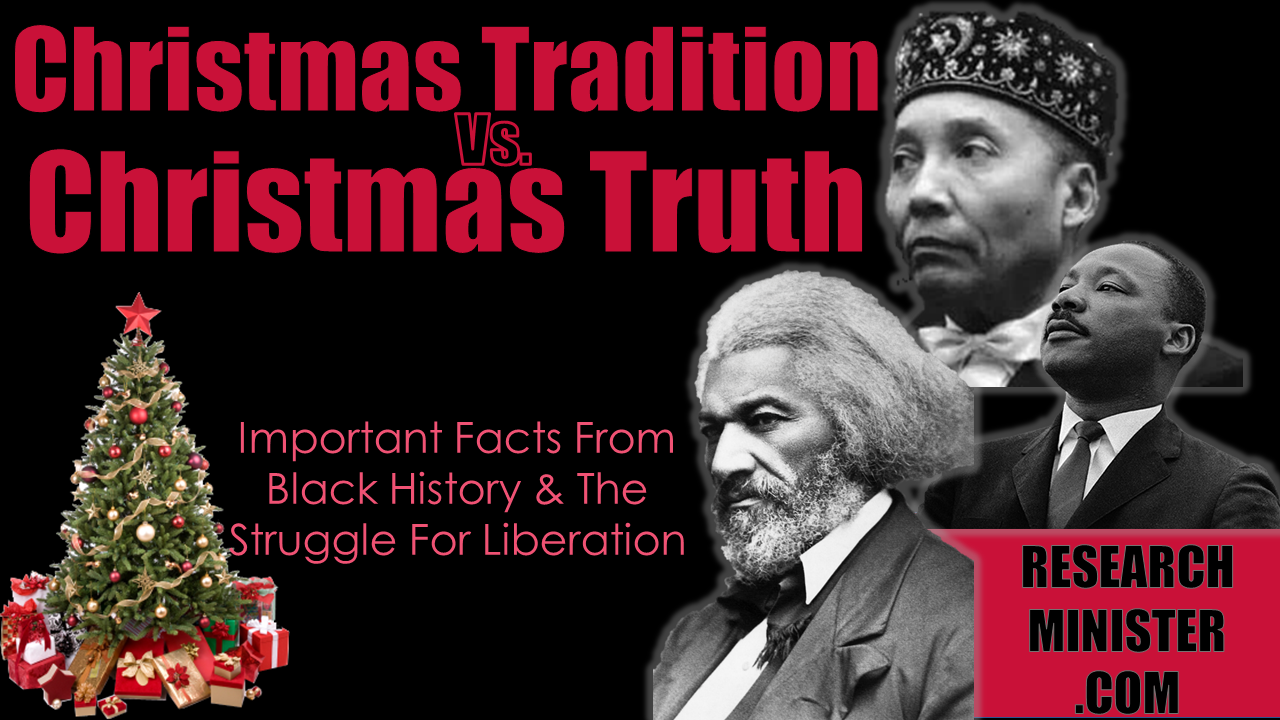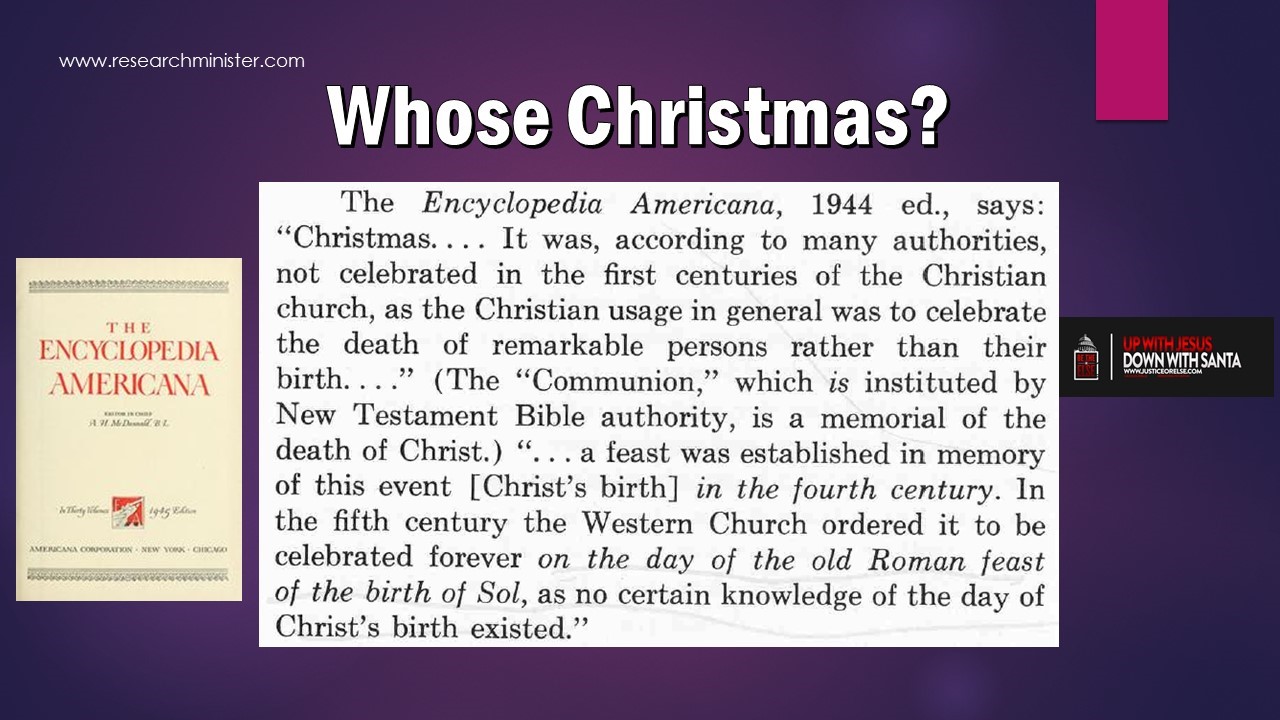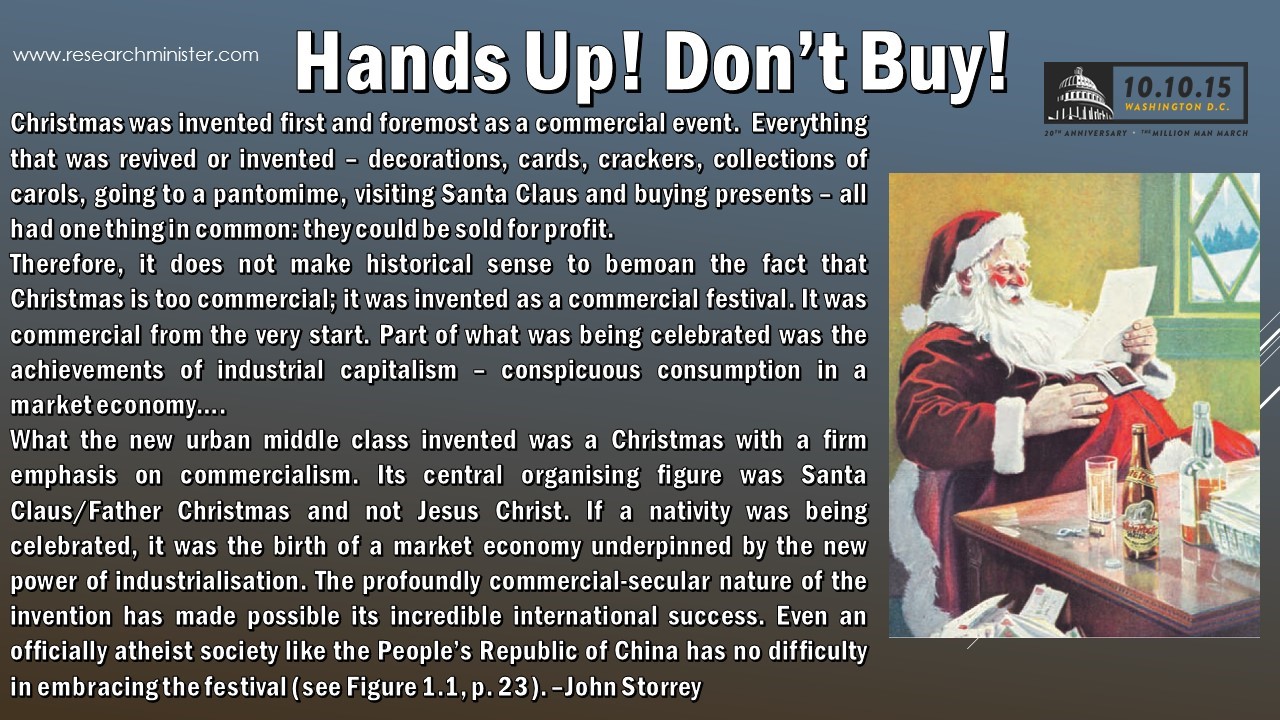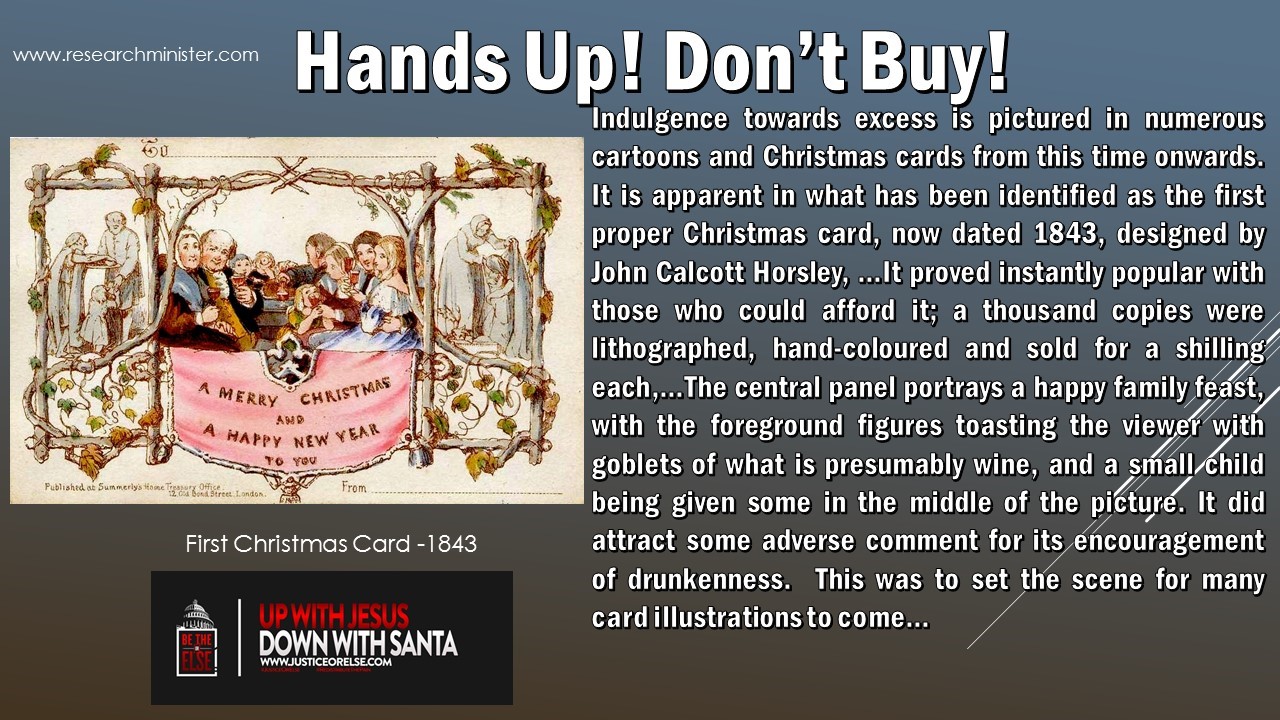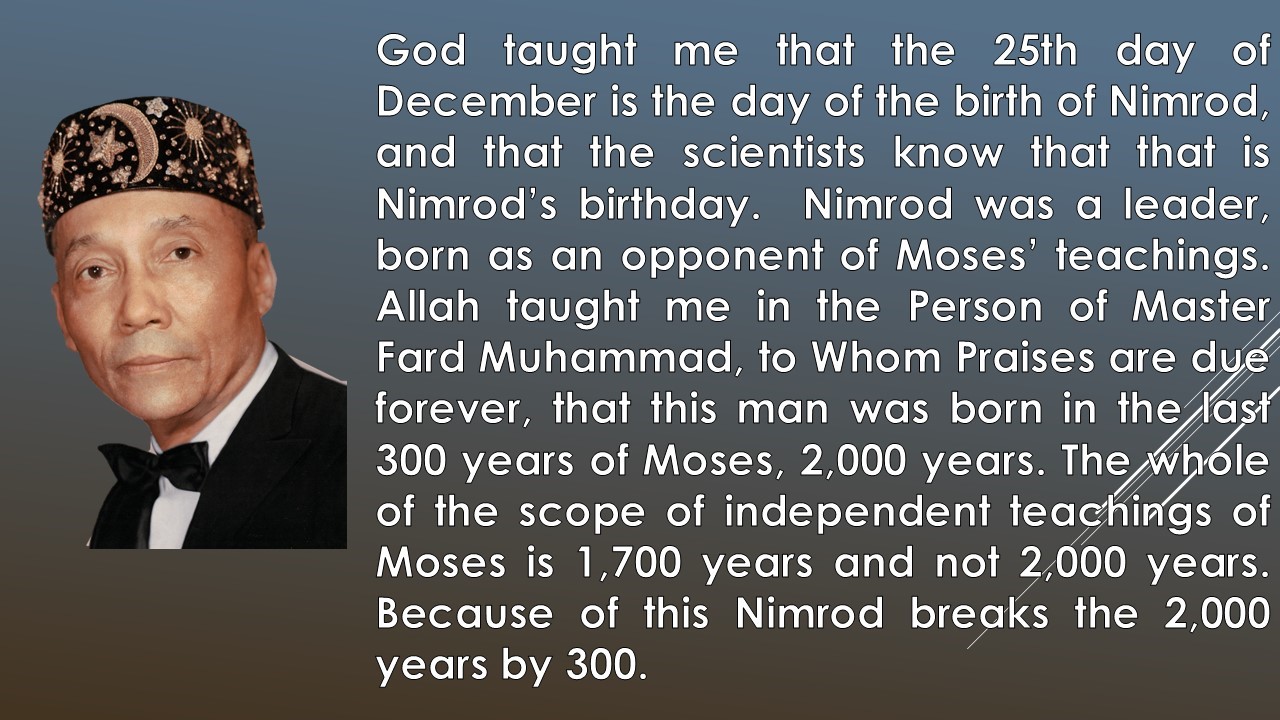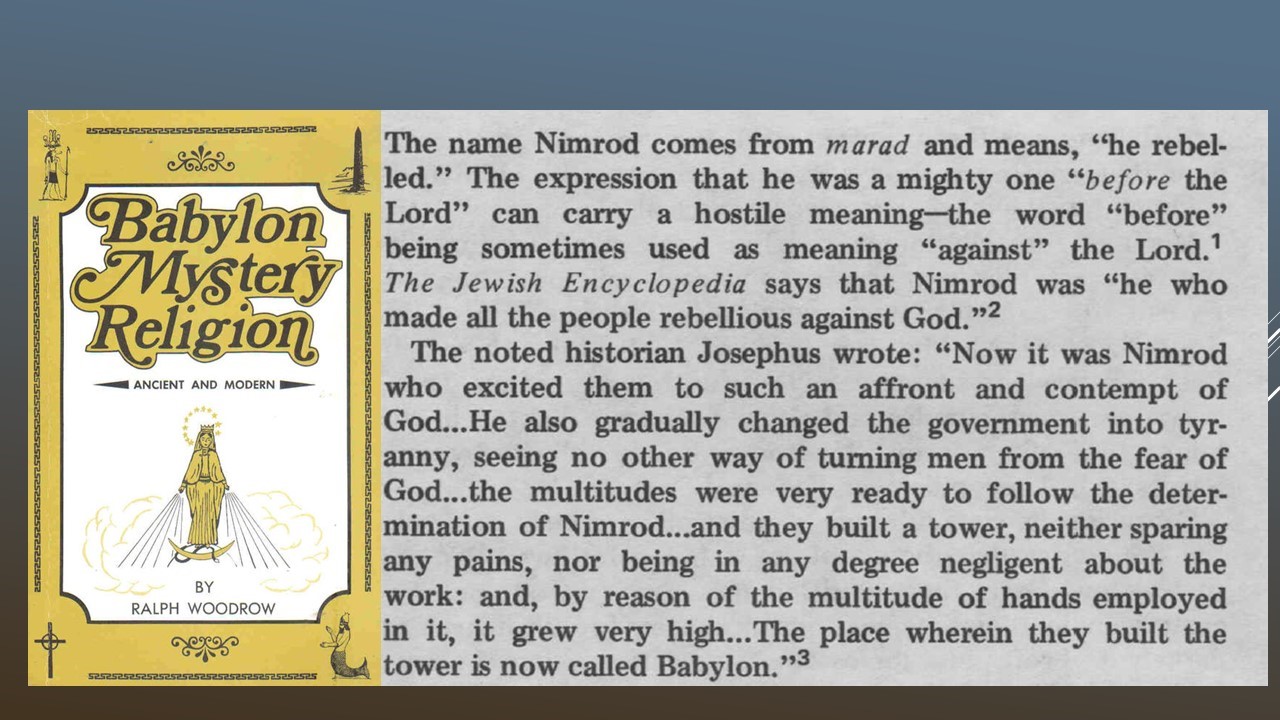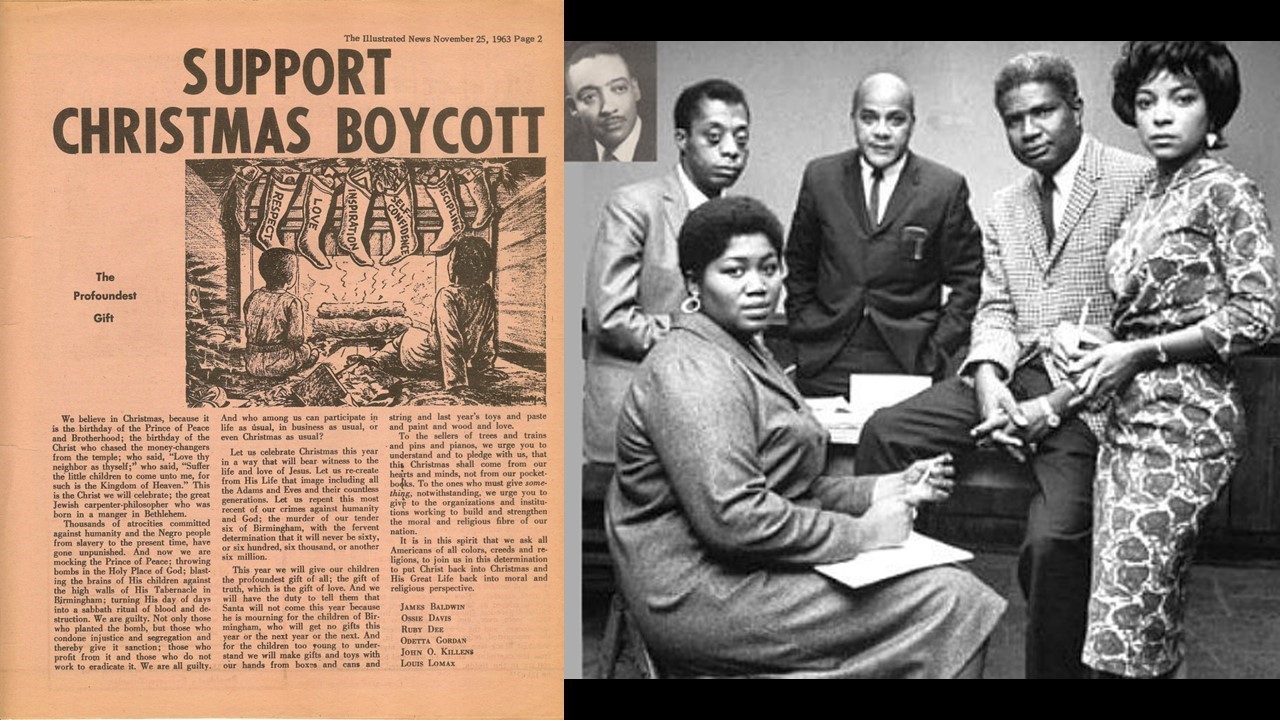CHRISTMAS TRADITION VS. CHRISTMAS TRUTH: Important Facts From Black History & the Struggle For Liberation
[ResearchMinister.Com below shares a fact sheet that we published last year to highlight the contrast between the beloved and cherished tradition of the Christmas Holiday and the truth of the history and use of the Christmas Holiday. With an emphasis on how the history and use of the Christmas Holiday has been a presence and has impacted the history of Black people in America, we share the following important facts and figures. To download this as a FREE PDF EBOOK, click on the above featured image. Thanks for reading]
FREDRICK DOUGLASS, NEW DUTIES AND RELATIONS, 1882: “[For Christmas]We were induced to drink, I among the rest, and when the holidays were over we all staggered up from our filth and wallowing, took a long breath, and went away to our various fields of work, feeling, upon the whole, rather glad to go from that which our masters had artfully deceived us into the belief was freedom, back again to the arms of slavery. It was not what we had taken it to be, nor what it would have been, had it not been abused by us. It was about as well to be a slave to master, as to be a slave to whisky and rum. When the slave was drunk, the slaveholder had no fear that he would plan an insurrection, or that he would escape to the North. It was the sober, thoughtful slave who was dangerous and needed the vigilance of his master to keep him a slave.”
REV. DR. MARTIN LUTHER KING JR’S “A STUDY OF MITHRAISM CITED IN THE ESSAY “DR. KING & HON. ELIJAH MUHAMMAD EXPOSE CHRISTMAS AS RICH MAN’S PAGAN HOLIDAY” BY DEMETRIC MUHAMMAD: “When Mithraism is compared with Christianity, there are surprisingly many points of similarity. Of all the mystery cults, Mithraism was the greatest competitor of Christianity. The cause for struggle between these two religions was that they had so many traditions, practices and ideas that were similar and in some cases identical.”
Dr. King goes on to highlight the fact that because of these similarities “many believed the Christian movement itself became a mystery cult.” He then lists 6 areas where Mithraism and Christianity are virtually indistinguishable from one another: “(1) both regarded Sunday as a holy day. (2) December 25 came to be considered as the anniversary of the birth of Mithra and Christ also. (3) Baptism and a communion meal were important parts of the ritual of both groups. (4) The rebirth of converts was a fundamental idea in the two cults. (5) The struggle with evil and the eventual triumph of good were essential ideas in both religions. (6) In both religions only initiates who passed through certain preliminary phases of introduction were admitted to the mysteries which brought salvation to converts.
We get a sense of Dr. King’s feeling upon these non-traditional histories of the origin of Christianity in his acknowledgment that there are so many similarities between Christianity and Mithraism that “the general effect is almost startling.”
Dr. King concludes his short essay with a bold confession. He writes, “That Christianity did copy and borrow from Mithraism cannot be denied…Many of the views, while passing out of Paganism into Christianity were given a more profound and spiritual meaning by Christians, yet we must be indebted to the source.
It is a shame that we have not been properly introduced to Dr. King as a religious scholar. For as a religious scholar we see him come into agreement with the Most Honorable Elijah Muhammad who taught for many years that the celebration of Jesus birth on December 25th is of pagan origin.”
MOST HON. ELIJAH MUHAMMAD, OUR SAVIOUR HAS ARRIVED: “So, you go out and spend your hard-earned money to worship with white people. They force you under disguise and defraud you into worshipping the birthday of that wicked old Nimrod on December. And if you knew the truth of him, you would not dare to worship it…
Nimrod gets a great ovation on the 25th day of December; one of the most wicked leaders that ever lived.…
The great false worship of December 25 is a lie. The worship of Jesus’ birthday, which they claim is on the 25th of December, is one of the most open lies against the truth. And the authors of their religion, Christianity, know that they are wrong in trying to tell the world that that is the day Jesus was born on….
God taught me that the 25th day of December is the day of the birth of Nimrod, and that the scientists know that that is Nimrod’s birthday. Nimrod was a leader, born as an opponent of Moses’ teachings…”
RALPH WOODROW’S BABYLON MYSTERY RELIGION AS CITED IN “DR. KING & HON. ELIJAH MUHAMMAD EXPOSE CHRISTMAS AS RICH MAN’S PAGAN HOLIDAY: BY DEMETRIC MUHAMMAD:“As proof that the “authors” and “scientists” of the Christian faith know the truth of which Mr. Muhammad and Dr. King have attested to, we bring to the “witness stand” noted scholar and author Ralph Woodrow who wrote an excellent book entitled Babylon Mystery Religion. On page 151, Woodrow quotes from James George Frazer’s book The Golden Bough that, “The largest pagan religious cult which fostered the celebration of December 25 as a holiday throughout the Roman and Greek worlds was the pagan sun worship-Mithraism…This winter festival was called ‘the Nativity’ –the ‘Nativity of the SUN’”. Woodrow continues “Was this pagan festival responsible for the December 25 day being chosen by the Roman Church?” Woodrow cites The Catholic Encyclopedia to provide a definitive answer to this question, “The well-known solar feast of Natalis Invicti”-the Nativity of the Unconquered Sun- “celebrated on December 25th, has a strong claim on the responsibility for our December date”!
Moreover, Woodrow writes “as pagan solar customs were being ‘Christianized’ at Rome, it is understandable that confusion would result. Some thought Jesus was Sol, the sun-god!”
Woodrow’s research and admissions even strike a blow at the gross consumerism of the Christmas ‘winter festival.’ He condemns the rationalization that gift exchanges should be the primary way to celebrate the birth of Jesus. According to Woodrow “Some have sought to link Christmas gifts with those presented to Jesus by the wise men. This cannot be correct. By the time the wise men arrived, Jesus was no longer ‘lying in a manger’ (as when the shepherds came), but was in a house (Matthew 2:9-11). This could have been quite a while after his birthday. Also, they presented their gifts to Jesus, not to each other.
On the use of Christmas trees Woodrow states “The Christmas tree as we know it, only dates back a few centuries, though ideas about sacred trees are very ancient. An old Babylonish fable told of an evergreen tree which sprang out of a dead tree stump. The old stump symbolized the dead Nimrod, the new evergreen tree symbolized that Nimrod had come to live again…”
HERBERT ARMSTRONG’S THE PLAIN TRUTH ABOUT CHRISTMAS AS CITED IN “DR. KING & HON. ELIJAH MUHAMMAD EXPOSE CHRISTMAS AS RICH MAN’S PAGAN HOLIDAY: BY DEMETRIC MUHAMMAD: “In addition to Woodrow popular 20th century Christian evangelist and scholar Herbert Armstrong ruffled many feathers when he published his popular The Plain Truth About Christmas. In it he notes that “recognized historical authorities show Christmas was not observed by Christians for the first 200 to 300 years-a period longer than the entire history of the United States as a nation!”
Rev. Armstrong’s scathing revelations and uncovering of Christmas’ true origin also agrees with that of the Most Honorable Elijah Muhammad and Rev. Dr. Martin Luther King Jr. On page of 11 of his pamphlet size tome Rev. Armstrong discusses Nimrod. We read “From many ancient writings, considerable is learned of this man who started the great organized worldly apostasy from God that has dominated this world until now. Nimrod was so evil, it is said he married his own mother, whose name is Semiramis. After Nimrod’s untimely death, his so-called mother-wife, Semiramis, propagated the evil doctrine of the survival of Nimrod as a spirit being. She claimed a full-grown evergreen tree sprang overnight from a dead tree stump, which symbolized the springing forth unto a new life of the dead Nimrod. On each anniversary of his birth, she claimed, Nimrod would visit the evergreen tree and leave gifts upon it. December 25th was the birthday of Nimrod. This is the real origin of the Christmas tree.”
WILLIAM W. FREEHLING CITED IN THE TIME O’ ALL TIMES? MASTERS, SLAVES, AND CHRISTMAS IN THE OLD SOUTH by SHAUNA BIGHAM AND ROBERT E. MAY: “Although William W. Freehling also presents Christmas within the context of a master class’s “psychological tyranny” over its subjects, he emphasizes the holiday more as a safety valve for slaveowners than for their slaves: masters, unsure of their legitimacy, translated the ostentatious, ceremonial bestowing of presents upon slaves, which elicited thanks from recipients to their “generous masters,”into “annual paternalistic re-elections.”
FREDERICK LAW OLMSTED CITED IN THE SUGAR MASTERS: PLANTERS & SLAVES IN LOUISIANA’S CANE WORLD, 1820-1860 by Richard Follett:  “Frederick Law Olmsted was not alone in concluding that “men of sense” found Christmas rewards a profitable way to create powerful economic and social ties between the enslaved and the enslavers. In parts of the South both before and after emancipation, a system of market paternalism served to motivate workers, reduce monitoring costs, and reaffirm the planters’ class power. Market paternalism, one historian argues, “must be built upon an illusion which conceals the commercially oriented nature of the employment contract.” Slaveholders accordingly had to veil their economically focused incentives beneath a façade of paternal reciprocity that seemingly bound the slave and his or her interests to the goodwill of the master. Such masking allowed slave masters to disguise their incentives – and the prevailing market dynamics of the master-slave relationship – with the sheen of paternalism. In order to do this, planters had to “handcraft their social authority link by link” through gifts, Christmas rewards, acts of apparent charity, and both practical and symbolic rituals.
“Frederick Law Olmsted was not alone in concluding that “men of sense” found Christmas rewards a profitable way to create powerful economic and social ties between the enslaved and the enslavers. In parts of the South both before and after emancipation, a system of market paternalism served to motivate workers, reduce monitoring costs, and reaffirm the planters’ class power. Market paternalism, one historian argues, “must be built upon an illusion which conceals the commercially oriented nature of the employment contract.” Slaveholders accordingly had to veil their economically focused incentives beneath a façade of paternal reciprocity that seemingly bound the slave and his or her interests to the goodwill of the master. Such masking allowed slave masters to disguise their incentives – and the prevailing market dynamics of the master-slave relationship – with the sheen of paternalism. In order to do this, planters had to “handcraft their social authority link by link” through gifts, Christmas rewards, acts of apparent charity, and both practical and symbolic rituals.
Olmsted further noted that both master and slave enforced a community-wide work discipline, and that “if any slave had been particularly careless or lazy, it was remembered at this Christmas dole…The effect of this arrangement was to give the laborers a direct interest in the economical direction of their labor: the advantage of which is said to be very evident.” For the sake of a few hundred dollars – a pittance in the annual costs of making sugar-the master succeeded in creating a highly-effective labor regime. Slackers received no payment at all, and the slaves self-policed themselves by exerting pressure on laggards.
COTTON MATHER, PURITAN SERMMON 1712: “[T]he Feast of Christ’s Nativity is spent in Reveling, Dicing, Carding, Masking, and in all Licentious Liberty…by Mad Mirth, by long Eating, by hard Drinking, by lewd Gaming, by rude Reveling…”
THE ABSENCE OF JUSTICE & PROPOSED BOYCOTTS
DESEGREGATING THE DOLLAR: AFRICAN-AMERICAN CONSUMERISM IN THE 20TH CENTURY BY ROBERT E WEES: “Although black consumers achieved a stunning victory in Birmingham during the spring of 1963, the national spotlight tragically returned to that city a few months later. On September 15, a powerful dynamite blast damaged the Sixteenth Street Baptist Church, killing four young black girls who were attending Sunday School. In addition, two black men were killed during disturbances following the bombing. These incidents, among other things, led to a call for a national black boycott during the Christmas season in late 1963.
The proposed Christmas boycott was the brainchild of an ad hoc organization known as “Actors and Writers for Justice.” The members of this group included the author James Baldwin, the journalist Louis Lomax, and the husband-and-wife acting team of Ossie Davis and Ruby Dee. Baldwin, the apparent organizer of Actors and Writers for Justice, told one public rally that what occurred in Birmingham “cost this nation the right to be called Christian.” Moreover, he declared: “We have got to bring the cat out of hiding, and where he is hiding is in the bank.”
From the standpoint of American businesses, the call by the Actors and Writers for Justice for a national black boycott during Christmas could not have come at a worse time. Ten days after the Birmingham murders, the Center for Research in Marketing released the findings of a study that, among other things, examined African American attitudes concerning consumer boycotts. When asked the question “If a prominent Negro were to tell you to boycott against a store or brand, what would you likely do?” 89 per cent of the blacks interviewed replied that they would follow the suggestion.
Armed with the data from the Center for Research in Marketing, along with a fervent belief in the righteousness of their proposal, Actors and Writers for Justice sought the support of other black leaders for a national boycott during the Christmas shopping season. To their disappointment, they received a lukewarm response. Of the six major civil rights organizations, only SCLC endorsed the proposed boycott. The other groups, most notably the NAACP, expressed doubt as to whether blacks could indeed carry out such a dramatic demonstration of economic retribution.
The October 17, 1963, edition of Jet magazine provided insight into the intracommunity debate concerning the feasibility of the Christmas boycott. An article that asked the question “Should Negroes boycott Santa Claus?” started by acknowledging the concerns of Roy Wilkins of the NAACP and other critics. Yet, after surveying recent developments regarding the behavior and growing power of black consumers, the essay’s author asserted:
Bluntly put, available research, even that from white sources, scream loudly that Negroes, just like Congressman Adam Clayton Powell urges, are ready at a moment’s notice to “withhold the dollar to make the white man holier.”
Ironically, while the October 17, 1963, issue of Jet appeared to subtly support the proposed Christmas boycott, the magazine’s publisher, John H. Johnson, staunchly opposed such an action. In an October 16, 1963, interview with Advertising Age, Johnson blasted the proposed boycott as a senseless endeavor proposed by a minuscule segment of the Civil Rights Movement. Moreover, he stated, children should not be denied the right to enjoy Christmas.
Johnson’s aversion to the Christmas boycott may have been based on more than a concern about children. By 1963 corporate marketers increasingly viewed advertising in Ebony and Jet as an ideal means to reach the black consumer market. Thus, Johnson, pleased with rising advertising revenues, had a vested interest in promoting African American consumption (see chapter 4).
Because of the strength and influence of its opponents, the 1963 black consumer boycott of Christmas shopping never came about. Still, just the threat of this action had a profound effect on white American business. As study after study revealed the growing importance of African American consumers to the U.S. economy, U.S. companies actively sought to befriend, rather than antagonize, black shoppers. In fact, as the June 20, 1964, issue of Business Week noted, businessmen played an important role in smoothing the passage and the acceptance by whites of the monumental Civil Rights Act of 1964. Still, white business support of this watershed legislation appeared to have much more to do with potential profits than with altruism.”
